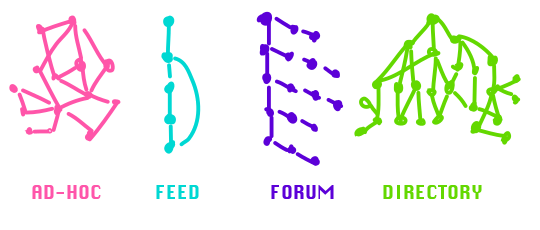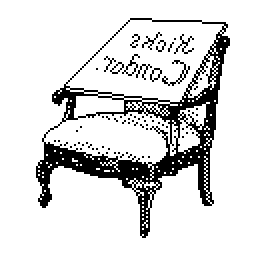
Hypertexting
‘Constructing a body of hypertext over time—such as with blogs or wikis—with an emphasis on the strengths of linking (within and without the text) and rich formatting.’
‘Constructing a body of hypertext over time—such as with blogs or wikis—with an emphasis on the strengths of linking (within and without the text) and rich formatting.’
A superset of blogging and wiki creation, as well as movements like the Indieweb and, to some degree, federated networks.
Does it include social networks like Twitter and Mastodon? Sure, depends on what you’re doing. If that network is helping you build a body of hypertext, is keeping you sufficiently ‘linked’ and gives you enough of an ability to format the text, then ‘super’—you are hypertexting in your way.
Although:
Ton Zijlstra:
At some point social software morphed into social media, and its original potential and value as informal learning tools was lost in my eyes.
I hope it goes without saying that Twitter is a limited form of hypertexting. It underutilizes the tech—that’s its whole point, right?
You can compartmentalize your various writings, though.
Jennifer Hill:
And you’re probably all sitting there and you’re like, “This girl wants me to delete Facebook, Instagram, Twitter… I got a following! I got a brand!”No, that’s not what I’m saying. You have two selves. You have a career self, who—I’m pretty sure all of us have to use Facebook, Instagram and Twitter for work or Medium or whatever other platform in the world you want to use—and then you have your personal self that knows the things that they’re doing. And what I’m speaking to right know is your personal self. You know, I understand you gotta make money, gotta make that dime…
But the point of the term is not to disqualify a certain technology or to try to channel disgust or disdain into something new—that’s exactly why the term is envisioned as a superset. I am extracting this term from what I am seeing develop on the Web.
On Supersets
A superset is the inversion of a subset. So, rather than dividing a topic into further subtopics—we combine related topics into a new ‘super’ topic. By redrawing the lines of the topic, it is possible to discover new subsets within the superset or to work with folks across the topic as a whole.
In this case, the superset seems superuseful since the division lines between the hypertext niches are almost entirely structural. (This isn’t entirely true: some structures imply, for example, centralization. A feed of interleaved user ‘stuff’ is done most simply by a single network housing that data—at least at first.)
I’m not even sure the subsets actually exist. It is already all hypertext that conforms to a variety of possible structures:

The blog (feed) and the wiki (ad-hoc) might not actually be different—despite that we think of wikis as being multi-writer (the original wikis anyone could edit, without respect to any record of permanent trolling demerits) and using a simplified markup that made linking fluid while writing—a blog can do what a wiki can do and vice versa.
By decoupling the hypertext from the implied structure of a wiki or blog, I can now look at these structures as mere arrangements of my hypertextual body.
Advanced Hypertexting
I think it’s worth repeating the criteria of ‘hypertexting’ so that it can be either corrected or remain crystal clear.
- A ‘body’ of hypertext is being created. Not just a single post or link.
- Linking is used both within and without the ‘body’. No comment on how this can be done ‘right’ or ‘wrong’. At the very least, though, this allows the body to be anything but merely linear.
- The formatting of the text is enhanced by inline imagery, charts, emoji, bullets, colors, aesthetics that allow the one hypertexting to communicate in addition to the letters themselves. (The standardization of HTML between us seems like a unique human collaboration that we should take advantage of. To some, this is all a distraction; to others, it is vital.)
There is nothing new at all here—in fact, it’s all becoming very old—but the superset distinction allow us to draw attention to the ‘body’ rather than the blog ‘post’ or the wiki ‘page’ and to ask: ‘what are we creating here?’ The body itself is a superset—and ‘hypertexting’ calls into focus what the work as a whole can be from a higher vantage point.
These three attributes imply an effort that goes beyond writing alone. The first creates a body whose length is practically infinite—no reader will likely consume it all. The second indicates that much research (both external and self-research) is required. And the third gives a sense of bottomless innovation to the publishing interface—in fact, as long as the body is able to remain intact, it can be published by anyone exactly as it is intended, as long as the browser remains compatible, which it has done remarkably well so far.
In addition, this gives us the impetus to preserve the browser’s life and compatibility, such that these bodies are kept alive.
Creating a body this large demands the ability to shape the structure. This is the problem: how do I begin to approach your giant monolith of hypertext beyond just reading your two or three latest posts?
What I would like to highlight is the ability of the author to use the ‘body’, its linking and formatting, to shape the structure. To infoshape.[1]
Link directories are clearly a part of this superset. Delicious and Pinboard themselves act as hypertexting swarms that work to connect the bodies. Maybe these connections fill holes in the body—maybe they act as introductions between bodies. They are a way to shape the info and annotate it slightly.
h0p3: I’m actually annoyed when people call my wiki a blog, since it is obviously not that to me. Of course, the fool in me starts wondering what exactly on the web doesn’t count as hypertexting? What doesn’t have a single entry point?
The home page is definitely the curated entry point. But it’s not just that entry point that’s important—the points that go deeper from there are important. h0p3’s home page was initially the most important thing to me. But now it’s the ‘recent changes’ page and the bookmarks I have that indicate where I intend to next explore further. Sometimes he is a blog, sometimes he is a wiki. Sorry, man!
So, (tentatively,) let’s look at three aspects of your hypertext:
- Permanent writings: thoughts that build over time into pages that act as storehouses or progressive essays—this page is that way for me.
- Emphemeral links, notes, partial thoughts: materials that either inform the permanent stuff or just act as simple interactions with others, participation in the present.
- Directory and search: ways of navigating the above.
To bring this into practice, here are a few interesting ways I’ve seen this play out:
Zylstra.org: This blog builds on itself day to day. In a way, posts become redundant because Ton is very careful to rewrite the same idea in different ways—to be sure it’s understood. I have read articles from 2008 that are only subtly different from others in 2018. But this makes sense—his message hasn’t been received yet. On top of this, he has a small directory for reading through his writings. I found this perfectly useful. You can do this kind of thing by hand, if you need to.
h0p3: I guarantee you’ve never seen a wiki used this way—as a backup for physical letters, as a way of messaging people, of writing drafts in public, of keeping detailed link logs, chat logs—it’s all in there. Links are used liberally throughout everything, so that you can track h0p3’s growing nomenclature.
More than half of hypertexting is the reading behind it—because if you are hypertexting in isolation, then you are missing out on a world of links.
Ton:
I treat blogging as thinking out loud and extending/building on others blogposts as conversation. Conversations that are distributed over multiple websites and over time, distributed conversations.
Discovering New Ways
What you might think of as ‘advanced hypertexting’ simply allows the shaping of the hypertext. Could we go beyond that?
- What pieces are the hypertext broken up into?
- How does one interchange or embed or inter-relate these texts?
- Can these pieces be composed into—not just texts—but shapes for the text?
To me, this is a great advantage of the superset. If the platform could see itself less as being a blog or a wiki or a directory, but as a collection of hypertexts that can be shaped, perhaps by hypertexts themselves. (Wikis—and TiddlyWiki in particular—have long had this abililty to make a page that displays the other pages as a blog. And some wikis allow you to include pages in other pages.)
The advanced hypertexting doesn’t end with the wiki—it’s just one way. I think Tumblr was initially on to something—aesthetic and piece layout are important here. Now add the ‘advanced’ hypertexting and what do you have?
TODO
(This is an unfinished steno—it could use a survey of the hypertexting field here. And it will be interesting to see where things go over the next six months. I will have to revisit this after I learn more.)
(I think the other missing discussion is how ‘ephemeral’ fragments fit into this. See also: Blogging.)
The other side of this coin is Infostrats—the reading of hypertext. ↩︎


